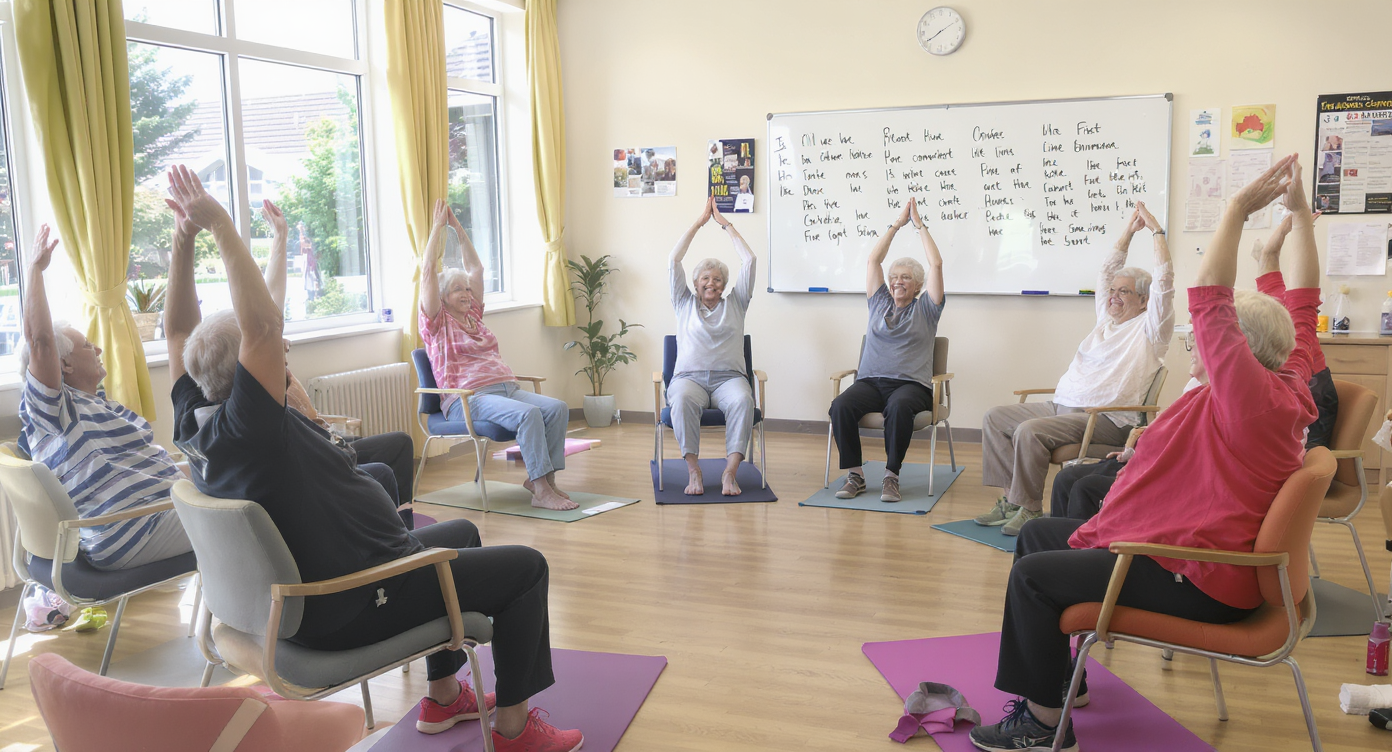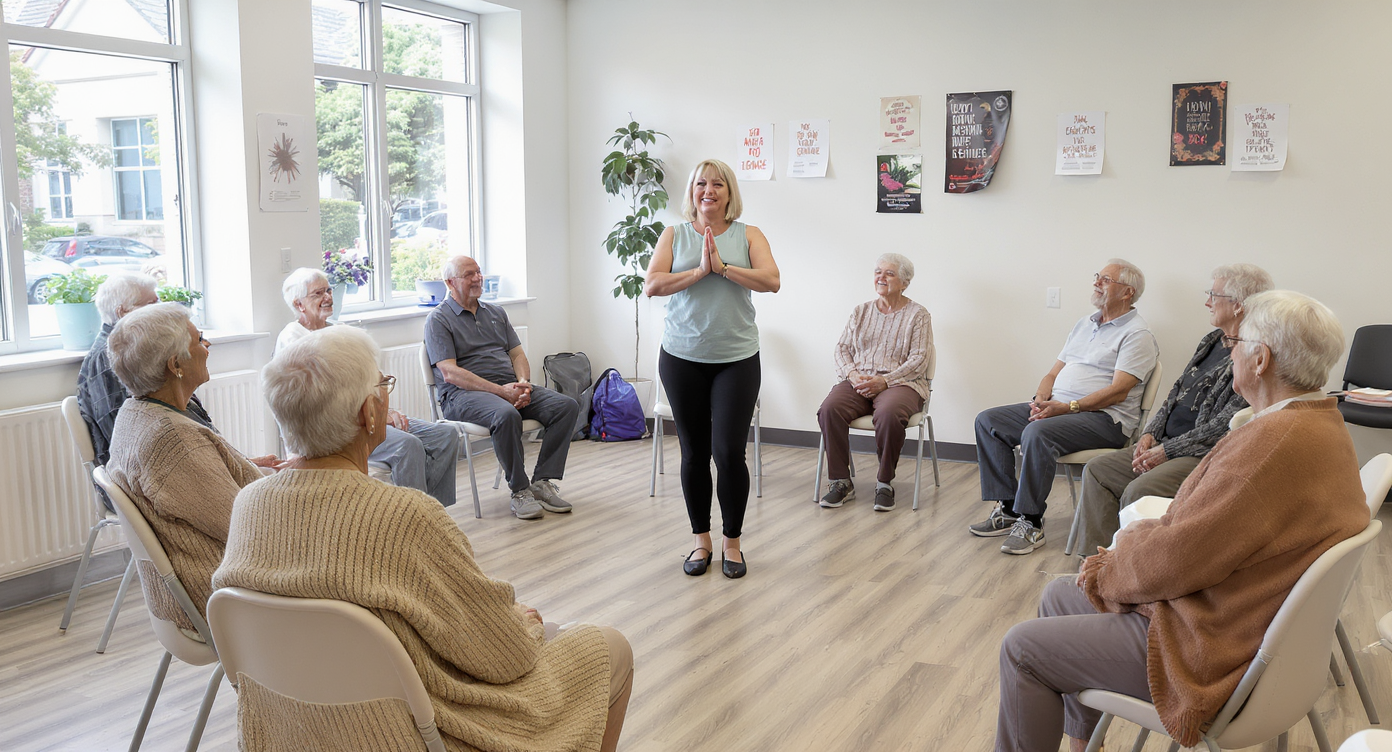Chair Yoga for Seniors: The Complete Guide to Safe, Effective Practice After 60
Now, I’ve seen enough folks in my day to know that the word “yoga” can make a 60-year-old feel about as comfortable as a long-tailed cat in a room full of rocking chairs. Thirty years of coaching taught me that most people picture those impossible pretzel poses they see on magazine covers and think, “Well, that ship has sailed.”
But here’s what I learned the hard way after my own knees started holding town hall meetings every morning: chair yoga isn’t some watered-down consolation prize. It’s actually a pretty brilliant adaptation that lets your body do what it was designed to do—move, stretch, and strengthen—without asking it to perform circus acts.

What Exactly Is Chair Yoga?
Think of chair yoga as yoga’s practical cousin who went to engineering school. It takes all the good stuff from traditional yoga—the stretching, strengthening, and that calm-your-mind business—and redesigns it so you can do it sitting down or using a chair for support.
Your body doesn’t care whether you’re twisted up like a corkscrew on the floor or gently stretching in a chair. What matters is that you’re moving those joints, working those muscles, and giving your nervous system a chance to downshift from the daily grind.
Here’s what’s fascinating about the human body: it responds to movement, period. Whether you’re 25 or 75, your muscles will get stronger if you challenge them consistently, and your joints will stay more flexible if you move them through their range of motion regularly.
The Science Behind Why Chair Yoga Works for Seniors
Let me tell you what the research actually shows, because it’s pretty encouraging. Studies have found that seniors who practice chair yoga regularly see measurable improvements in strength, balance, and flexibility.
One study I came across tracked older adults doing chair yoga twice a week for eight weeks. Their balance scores improved significantly, and—this is the part that would make any old coach proud—their fear of falling decreased. When people stop being afraid of their own bodies, they start moving more, which makes them stronger and more stable. It’s a beautiful cycle.
Your body’s been doing this dance for millions of years. The muscles that keep you upright and moving are like a good team—they need consistent training, not just game-day heroics. Chair yoga gives them that consistent work without asking them to perform miracles.
Essential Chair Yoga Poses for Beginners Over 60
Seated Cat-Cow: Your Spine’s Best Friend
This one’s as gentle as a spring rain and twice as refreshing. Sitting tall in your chair, arch your back slightly as you look up (that’s cow), then round your spine and drop your chin toward your chest (that’s cat).
I tell my clients this move is like giving your spine a gentle massage from the inside. After years of hunching over desks, driving cars, and generally living life forward-bent, your spine appreciates the chance to move in both directions.
Chair Warrior: Building Strength the Smart Way
Here’s where chair yoga gets sneaky good. Sitting sideways in your chair, extend one leg straight back while keeping the other foot planted. You’re working those hip flexors and glutes—the same muscles that power you up stairs and out of chairs.
The beautiful thing about biology is that your muscles don’t know you’re sitting down. They just know they’re working against resistance, and they respond accordingly.
Seated Sun Salutations: Full-Body Movement
This sequence gets your whole body involved without requiring you to touch your toes or stand on one foot. Raise your arms overhead, fold forward gently, twist side to side—it’s like taking your body through its complete user manual.
Ankle Circles and Calf Raises: The Unsung Heroes
Never underestimate the power of working those lower legs. Your calves are like your body’s auxiliary heart, pumping blood back up from your feet. Simple ankle circles and calf raises keep that system running smoothly.
Choosing the Right Equipment: No Need to Break the Bank
The Chair: Your Most Important Partner
You don’t need some fancy yoga chair that costs more than your first car. A sturdy dining chair without arms works perfectly. Make sure it doesn’t roll, rock, or wobble—you want something as reliable as an old pickup truck.
The seat should be firm enough to support you but not so hard that you’re uncomfortable. Your feet should touch the floor comfortably. If they don’t, a phone book or yoga block under your feet works just fine.
Mats: When and Why You Might Need One
If you’re planning to do any standing poses using the chair for support, a yoga mat can prevent slipping. Look for one that’s at least 6mm thick—your knees will thank you if you end up doing any kneeling stretches.
But honestly, for pure seated work, the mat is optional. Don’t let the lack of perfect equipment keep you from starting.
Props That Actually Help
Yoga blocks are handy for bringing the floor closer to you if you can’t reach comfortably. A strap can help you hold poses without straining. But here’s the thing—a folded towel works as well as a fancy yoga block, and a belt works as well as a yoga strap.
The goal is movement, not perfect equipment.
Safety First: What Every Senior Should Know
Here’s what thirty years of working with bodies has taught me: pain is not gain when you’re over 60. That old football mentality needs to stay in the locker room.
Listen to your body like you’d listen to a good friend giving you advice. If something hurts, back off. If you feel dizzy, stop and breathe. If your balance feels off, use that chair for extra support.
Always check with your doctor before starting any new exercise program, especially if you have heart issues, balance problems, or recent injuries. This isn’t legal fine print—it’s genuinely important.
The Balance and Fall Prevention Connection
Now, this is where chair yoga really shines. Falls are responsible for more injuries in seniors than just about anything else, and most of them happen because of balance issues or fear of falling.
Chair yoga works on both problems simultaneously. The physical poses strengthen the muscles you need for balance—your core, legs, and the little stabilizer muscles you never think about. But just as importantly, practicing balance in a safe environment builds confidence.
When you’re not afraid of falling, you move more naturally and confidently, which actually makes you less likely to fall. It’s like how learning to drive in an empty parking lot makes you a better driver on the highway.
Building Lower Body Strength: The Moves That Matter Most

If I had to pick the most important exercises for maintaining independence after 60, they’d all involve your legs and hips. These are the muscles that get you out of chairs, up stairs, and through your daily life.
Chair Squats: The King of Functional Movements
Start by sitting in your chair, then stand up and sit back down using as little hand support as possible. This movement mimics exactly what you need to do dozens of times every day.
Start with whatever feels comfortable—maybe 5 repetitions—and build from there. Your thigh muscles are like any other muscle: they get stronger when you ask them to work consistently.
Seated Leg Extensions
While sitting, straighten one leg out in front of you, hold for a few seconds, then lower it slowly. This strengthens your quadriceps—the muscles on the front of your thighs that are crucial for walking and standing.
Marching in Place
Lift your knees alternately while seated, like you’re marching to a very slow band. This works your hip flexors and helps maintain the coordination you need for walking.
How Often Should You Practice?
Here’s where I channel my inner Goldilocks: not too much, not too little, but just right. For most people over 60, that means 20-30 minutes, 3-4 times per week.
Consistency beats intensity every time. Better to do 15 minutes three times a week for a year than to do an hour once a week for a month and then quit.
Your body adapts gradually, like a river carving a canyon. Give it time to adjust, strengthen, and improve.
Common Mistakes to Avoid
The biggest mistake I see is people trying to do too much too soon. Chair yoga isn’t a race—it’s a conversation with your body that should last for years.
Don’t worry about looking graceful or getting poses “perfect.” Your 60-year-old body doesn’t need to look like a 25-year-old yoga instructor. It just needs to move better than it did yesterday.
Also, don’t hold your breath during poses. Your muscles need oxygen to work properly, and holding your breath just makes everything harder.
The Mental Health Benefits: More Than Just Physical
Here’s something beautiful that happens when you start moving regularly: your mood improves. Not because of some mystical yoga magic, but because movement releases natural mood-boosting chemicals in your brain.
The focus required for chair yoga also gives your mind a break from worrying about bills, health issues, or whatever else keeps you up at night. It’s like meditation for people who think they can’t meditate.
Getting Started with Chair Yoga for Seniors: Your First Week
Week one should feel like a gentle introduction, not boot camp. Try 3-4 basic poses, hold them for 15-30 seconds each, and focus on breathing normally.
Don’t worry about doing them perfectly. Your body is relearning how to move in these ways, and that takes time.
Many people find it helpful to follow along with online videos at first. YouTube has dozens of chair yoga routines specifically designed for seniors. Find an instructor whose voice doesn’t annoy you—you’ll be spending time together.
When to Progress and When to Stay Put
Your body will tell you when it’s ready for more challenge. Maybe you can hold poses a little longer, or add a few more repetitions, or try a slightly more difficult variation.
But here’s the key: progress should feel good, not painful. If your knees are aching the day after chair yoga, you probably pushed too hard.
The goal isn’t to become a yoga master. The goal is to maintain and improve your strength, flexibility, and balance so you can keep doing the things you love for as long as possible.
Finding Community: Classes vs. Home Practice
Both have their place. Home practice gives you privacy and the freedom to go at your own pace. Classes provide social connection and professional guidance.
Many community centers, senior centers, and yoga studios offer chair yoga classes specifically for older adults. The instructor can make sure you’re doing poses safely and can suggest modifications based on your specific needs.
If you’re the social type, classes can be a great way to meet like-minded people. If you prefer privacy, home practice works just fine.
The Bottom Line on Chair Yoga for Seniors
Chair yoga for seniors isn’t about becoming more flexible than a circus performer or stronger than a weightlifter. It’s about maintaining the strength, balance, and flexibility you need to live independently and confidently.
Your body is remarkably adaptable, even after 60. Give it consistent, gentle challenges, and it will respond by getting stronger and more resilient. Chair yoga provides those challenges in a safe, accessible way that works with your body’s current capabilities, not against them.
Most importantly, it can help you feel more confident in your own skin. And that confidence—that sense that your body is capable and reliable—might just be the most valuable benefit of all.
After all, aging well isn’t about stopping time. It’s about moving through time with strength, grace, and the confidence that comes from taking good care of the only body you’ve got.
